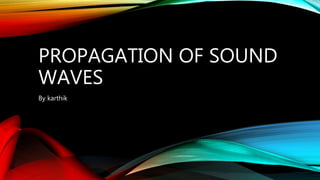
PROPAGATION OF SOUND WAVES: EXPERIMENTS AND PROPERTIES
- 1. PROPAGATION OF SOUND WAVES By karthik
- 2. WHAT IS SOUND AND EXPERIMENTS ON VIBRATION • Sound is a form of energy that produces the sensation of hearing • Sound is produced when a body is vibrating • Experiment 1: is a string of a guitar is plucked the string starts vibrating and sound is heard • Experiment 2: Take thin wire stretch it between 2 nails. place a small piece of paper on the wire as a rider. pluck the string near the rider it is shown the rider flies off and the string starts vibrating and sound is heard. • Experiment 3: Take a tuning fork and strike to a rubber pad. Then take it near a ball suspended by a thread. when the vibrating tuning fork is brought close to the ball the ball moves away and sound of vibrating tuning fork is heard. • From the above experiments we can prove that sound is produced vibration and sound ceases when vibration stops.
- 3. MEDIUM OF SOUND PROPAGATION • Sound produced by a vibrating body travels form one place to the other through vibrations of particles of the medium in wave form. • Thus, Sound requires a material medium to travel from one place to the other. • Bell jar Experiment :Take an electric bel and place it in an airtight glass bell jar. Connect the vacuum pump to the bell jar. First turn on the switch and we can see the hammer hitting the gong and sound being produced. Then when we suck all the air out of the bell jar and turn the switch on again. We can see the hammer hit the gong so we no vibrations are produced, but hear no sound. • Sound cannot travel in a vacuum. • Light does not require a medium for its propagation and can propagate through vacuum as well.
- 4. OBJECTIVES OF THE SOUND MEDIUM • The particles should be capable of vibrating about their mean positions. • The medium must remain unchanged (inertia) so that its particles may store mechanical energy for a given time. • The medium must remain frictionless so that there is no loss of energy in propagation of sound through it. • Sounds can propagate not only in gases but in solids and liquids as well. • This is decreasing order of sound in medium. • Some materials propagate sound (air) and some materials absorb sound. (thick curtains) solids liquids gases
- 5. PROPAGATION OF SOUND IN A MEDIUM • When we talk depending on the direction we talk sound is transmitted i. There are fast moving particles that make up air ii. When we talk the sound wave produced goes through the air iii. The sound wave groups the particles into 2 groups iv. The particles which are closely packed are called compressions v. The space between the waves which particles are far apart and rare are called rarefactions characteristics of wave motion----
- 6. TERMS OF WAVE MOTION • Amplitude is the maximum extent of a oscillation, measured from the position of equilibrium. • Time period is the time taken by a particle of a medium to complete one vibration. • Frequency is the number of vibrations made by a particle of medium in 1 second. • Wavelength is the distance travelled between 1 time period of vibration of particle of the medium • Wave velocity is the distance travelled by a wave in 1second.
- 7. TYPES OF GRAPHS Displacement time graph Displacement distance graph • The variation of displacement with time • for a particle of the medium at a given position • when a wave propagates through the medium • A Displacement – Distance graph shows the position of each particle in a wave relative to its distance from a reference point. • The distance between 2 successive crest or trough is the wavelength. • The maximum displacement of the particles from the equilibrium position is the amplitude.
- 8. RELATION BETWEEN WAVELENGTH WAVE VELOCITY AND FREQUENCY • 𝑤𝑎𝑣𝑒𝑙𝑒𝑔𝑛𝑡ℎ 𝜆 = 𝑑𝑖𝑠𝑡𝑎𝑛𝑐𝑒 𝑡𝑟𝑎𝑣𝑒𝑙𝑙𝑒𝑑 𝑏𝑦 𝑡ℎ𝑒 𝑤𝑎𝑣𝑒 𝑖𝑛 𝑜𝑛𝑒 𝑡𝑖𝑚𝑒 𝑝𝑒𝑟𝑖𝑜𝑑 • 𝑤𝑎𝑣𝑒𝑙𝑒𝑔𝑛𝑡ℎ 𝜆 = 𝑤𝑎𝑣𝑒 𝑣𝑒𝑙𝑜𝑐𝑖𝑡𝑦 𝑥 𝑡𝑖𝑚𝑒 𝑝𝑒𝑟𝑖𝑜𝑑 • 𝑤𝑎𝑣𝑒𝑙𝑒𝑔𝑛𝑡ℎ 𝜆 = 𝑉 𝑥 𝑇 (𝜆 = 𝑉𝑇) • 𝑏𝑢𝑡 𝑡𝑖𝑚𝑒 = 𝑜𝑛𝑒 𝑏𝑦 𝑓𝑟𝑒𝑞𝑢𝑒𝑛𝑐𝑦 𝑇 = 1 𝑓 • 𝑉 𝑥 1 𝑓 = 𝜆 • 𝑉 = 𝑓𝜆 • Wave velocity = frequency x wavelength
- 9. SOUND AND HUMANS • 20 to 20,000 Hz is the audible range • our hearing is most sensitive in the 2000 - 5000 Hz frequency range. • Your ear can stand a maximum of 85 decibel as an average noise level over a day, before it is damaged by the noise. • The sound level of normal conversation is between 50 and 65 decibels, speaking generally.
- 10. COMPARISON OF FREQUENCIES ultrasonic Sound of above 20,000 Hz is called ultrasound. Energy carried by the ultrasound is very high Ultrasound can travel along a well defined strait path. It does not bend appreciably at the edges of an obstacle because of its small wavelength. Bats avoid obstacles in their path by producing and hearing the ultrasonic waves which returns after striking the obstacle. By hearing the reflected sound they judge their direction of the obstacle. Ultrasound is used for drilling holes or making cuts of desired shape in materials sonic Frequencies in the range 20Hz to 20kHz is called the sonic or audible sound. infrasonic sound waves below the frequencies of audible sound, and nominally includes anything under 20 Hz. soot cleaners and for integrity monitoring. Used to detect earthquakes The waves are efficiently reflected from the surface and may be transmitted by multiple “bounces” to more distant regions. For example, infrasound detected by us from Mexican earthquakes would have made about 10 bounces to reach the detectors